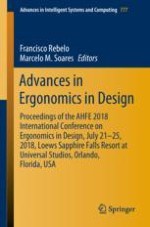This book provides readers with a timely snapshot of ergonomics research and methods applied to the design, development and prototyping – as well as the evaluation, training and manufacturing – of products, systems and services. Combining theoretical contributions, case studies, and reports on technical interventions, it covers a wide range of topics in ergonomic design including: ecological design; educational and game design; cultural and ethical aspects in design; user research and human–computer interaction in design; as well as design for accessibility and extreme environments, and many others. The book particularly focuses on new technologies such as virtual reality, state-of-the-art methodologies in information design, and human–computer interfaces. Based on the AHFE 2018 International Conference on Ergonomics in Design, held on July 21–25, 2018, in Orlando, Florida, USA, the book offers a timely guide for both researchers and design practitioners, including industrial designers, human–computer interaction and user experience researchers, production engineers and applied psychologists.
